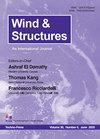Thrust force and base bending moment acting on a horizontal axis wind turbine with a high tip speed ratio at high yaw angles
IF 1.9
4区 工程技术
Q3 CONSTRUCTION & BUILDING TECHNOLOGY
引用次数: 0
Abstract
Onshore wind turbines may experience substantially different wind loads depending on their working conditions, i.e., rotation velocity of rotor blades, incoming freestream wind velocity, pitch angle of rotor blades, and yaw angle of the wind-turbine tower. In the present study, aerodynamic loads acting on a horizontal axis wind turbine were accordingly quantified for the high tip speed ratio (TSR) at high yaw angles because these conditions have previously not been adequately addressed. This was analyzed experimentally on a small-scale wind-turbine model in a boundary layer wind tunnel. The wind-tunnel simulation of the neutrally stratified atmospheric boundary layer (ABL) developing above a flat terrain was generated using the Counihan approach. The ABL was simulated to achieve the conditions of a wind-turbine model operating in similar inflow conditions to those of a prototype wind turbine situated in the lower atmosphere, which is another important aspect of the present work. The ABL and wind-turbine simulation length scale factors were the same (S=300) in order to satisfy the Jensen similarity criterion. Aerodynamic loads experienced by the wind-turbine model subjected to the ABL simulation were studied based on the high frequency force balance (HFFB) measurements. Emphasis was put on the thrust force and the bending moment because these two load components have previously proven to be dominant compared to other load components. The results indicate several important findings. The loads were substantially higher for TSR=10 compared to TSR=5.6. In these conditions, a considerable load reduction was achieved by pitching the rotor blades. For the blade pitch angle at 90°, the loads were ten times lower than the loads of the rotating wind-turbine model. For the blade pitch angle at 12°, the loads were at 50% of the rotating wind-turbine model. The loads were reduced by up to 40% through the yawing of the wind-turbine model, which was observed both for the rotating and the parked wind-turbine model.在高偏航角下作用在具有高叶尖速比的水平轴风力涡轮机上的推力和基础弯矩
陆上风力涡轮机根据其工作条件,即转子叶片的旋转速度、进入的自由流风速、转子叶片的桨距角和风力涡轮机塔架的偏航角,可能经历实质上不同的风载荷。在本研究中,作用在水平轴风力涡轮机上的空气动力学载荷被相应地量化为高偏航角下的高叶尖速比(TSR),因为这些条件以前没有得到充分解决。这是在边界层风洞中的小型风力涡轮机模型上进行的实验分析。使用Counihan方法生成了在平坦地形上发展的中性分层大气边界层(ABL)的风洞模拟。对ABL进行了模拟,以实现在与位于较低大气中的原型风力涡轮机相似的流入条件下运行的风力涡轮机模型的条件,这是本工作的另一个重要方面。ABL和风力涡轮机模拟长度比例因子相同(S=300),以满足Jensen相似性标准。基于高频力平衡(HFFB)测量,研究了风力涡轮机模型在ABL模拟下所经历的气动载荷。重点放在推力和弯矩上,因为这两个载荷分量先前已被证明与其他载荷分量相比占主导地位。结果表明了几个重要的发现。与TSR=5.6相比,TSR=10的负载显著更高。在这些条件下,通过使转子叶片变桨,可以显著降低负载。对于90°的叶片桨距角,载荷比旋转风力涡轮机模型的载荷低十倍。对于12°的叶片桨距角,载荷为旋转风力涡轮机模型的50%。通过风力涡轮机模型的偏航,负载减少了40%,这在旋转和停放的风力涡轮机模型中都有观察到。
本文章由计算机程序翻译,如有差异,请以英文原文为准。
求助全文
约1分钟内获得全文
求助全文
来源期刊

Wind and Structures
工程技术-工程:土木
CiteScore
2.70
自引率
18.80%
发文量
0
审稿时长
>12 weeks
期刊介绍:
The WIND AND STRUCTURES, An International Journal, aims at: - Major publication channel for research in the general area of wind and structural engineering, - Wider distribution at more affordable subscription rates; - Faster reviewing and publication for manuscripts submitted.
The main theme of the Journal is the wind effects on structures. Areas covered by the journal include:
Wind loads and structural response,
Bluff-body aerodynamics,
Computational method,
Wind tunnel modeling,
Local wind environment,
Codes and regulations,
Wind effects on large scale structures.
 求助内容:
求助内容: 应助结果提醒方式:
应助结果提醒方式:


